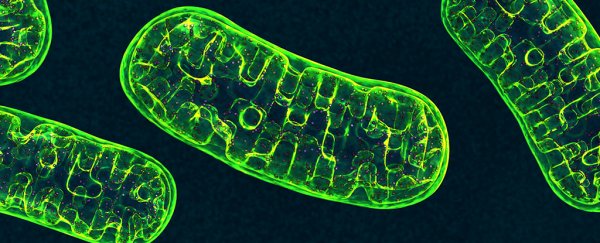If you've ever studied biology, you'll be familiar with mitochondria - the organelles often referred to as the 'powerhouse of the cell'. And you'll probably be aware that they're often compared to traditional AA batteries, with each organelle operating as a single unit.
But an important new study suggests they're actually more like the cutting edge battery packs inside Tesla's cars - with each fold inside the mitochondria providing power independently.
And that actually makes a lot of sense. The reason Tesla's become such a big name in electric cars and power storage is because their battery systems are capable of packing a whole lot of energy into a small space - while ensuring the failure of one part doesn't bring down the whole setup.
Now new research by American and German scientists suggests that nature may have thought up a similar system first.
The mitochondrion plays a key role in moving the energy locked up in the bonds of glucose into a form that can be utilised more easily as fuel for the cell.
To manage this process, the several micrometre long bean-shaped structure contains an undulating inner membrane peppered with channels that shuttle positively charged hydrogen ions back and forth.
Folds in this inner membrane called cristae were assumed to increase the surface area for these protein portals, maximising the output of individual mitochondria.
It's a fair assumption to make. In some ways, a solitary mitochondrion seems a little like an old fashioned electrochemical cell.
Both are defined by a reservoir of chemicals next to an interface that helps channel their energy into something a little more useful. So having more folds would mean a larger space for that exchange to take place.
It's such a convenient metaphor, few have ever bothered to ask just how accurate it might be.
"Nobody had looked at this before because we were so locked into this way of thinking; the assumption was that one mitochondrion meant one battery," says endocrinologist Orian Shirihai from the University of California, Los Angeles.
For all the model's simplicity, it takes some big risks as far as redundancy goes. A catastrophic breakdown in a central part of the process would potentially mean an end to that powerhouse.
If a simple battery fails inside a flashlight or small toy, it's hardly a problem. Just swap it for a new one.
But when a power unit responsible for pushing several tonnes of vehicle down the highway at 100 kilometres an hour fails, it pays to have a Plan B.
"Electric vehicle engineers told me about advantages of having many small battery cells instead of one large one; if something happens to one cell, the system can keep working, and multiple small batteries can provide a very high current when you need it," says Shirihai.
That's part of the reason why the lithium ion batteries that power electrical cars like Tesla's Model S aren't one big cell but more than 7,000 tiny ones connected together, each contributing a small amount of power while acting independently.
Many living cells have a bunch of mitochondria, probably for similar reasons. Losing one isn't a major issue if there's another dozen to pick up the slack.
But Shirihai had seen cells with no more than a handful of long mitochondria, where a single loss could potentially be devastating.
To test the one mitochondrion/one battery model, the endocrinologist and his team used high resolution microscopy and staining techniques to observe the fine details of mitochondria inside several different types of human cell.
The staining also allowed them to determine how a voltage difference called the mitochondrial membrane potential varied along the meandering curtain of inner membrane.
If the whole membrane had the same potential, or if everything depolarised when a single cristae was damaged, a single mitochondrion could be considered to be acting as a unit. But that isn't what Shirihai and his team saw at all.
"What the images told us was that each of these cristae is electrically independent, functioning as an autonomous battery," says Shirihai.
"One cristae can get damaged and stop functioning while the others maintain their membrane potential."
Knowing more about how mitochondria govern their internal processes could tell us a lot about how we age, or why some suffer from disorders such as chronic fatigue syndrome.
Mitochondria can still be thought of us our cell's battery. It's simply one that's far more advanced than we ever gave nature credit for.
This research was published in EMBO Journal.
